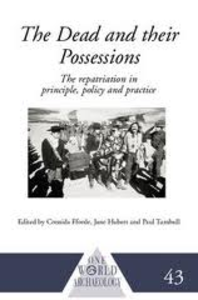Indigenous Australian people, their defence of the dead and native title
Turnbull, Paul (2002) Indigenous Australian people, their defence of the dead and native title. In: Fforde, Cressida, Hubert, Jane, and Turnbull, Paul, (eds.) The Dead and Their Possessions: repatriation in principle, policy and pratice. One World Archaeology, 43 . Routledge, London, UK, pp. 63-86.
|
PDF (Published Version)
- Published Version
Restricted to Repository staff only |
||
![[img]](https://researchonline.jcu.edu.au/14383/2.hassmallThumbnailVersion/14383_Turnbull_2002_front_cover.jpg)
|
Image (JPEG) (Front Cover)
- Cover Image
Download (7kB) |
Abstract
[Extract] In July 2000, the indigenous peoples of Australia achieved significant progress in their struggle to regain ownership and determine the fate of ancestral remains preserved in western museums and medical schools.That month, a Select Committee of the British House of Commons recommended that the Department for Culture, Media and Sport initiate discussions with appropriate representatives of museums, of claimant communities and of appropriate Governments to prepare a statement of principles and accompanying guidance relating to the care and safe-keeping of human remains and to the handling of requests for return of human remains. (Culture, Media and Sport Select Committee 2000)
This was less than the representatives of indigenous Australian people, who appeared before the committee, had hoped for, but they still saw this recommendation as an important step towards resolving an issue which has long caused anguish in Aboriginal and Torres Strait Islander communities. In submissions and evidence before the committee, museum administrators acknowledged the distress that the continued preservation of remains caused. Regrettably, there were items in their custody that had been procured in historical circumstances which were wholly at odds with contemporary ethical standards governing the conduct of scientific research. Even so, their testimony reflected the unease within scientific communities at the prospect of returning remains and having them lost to science through reburial. For example, Neal Chalmers, representing the Natural History Museum, argued that the Museum would find it extremely difficult to agree to repatriation, believing that it had a duty to the nation to retain those objects and we have a duty to the scientific international community to use them as a very valuable scientific resource.We would find it extremely difficult to return any such objects if there was any doubt at all about their continued safety and their accessibility. (Culture, Media and Sport Select Committee 2000)
| Item ID: | 14383 |
|---|---|
| Item Type: | Book Chapter (Research - B1) |
| ISBN: | 978-0-203-16577-5 |
| Keywords: | Indigenous australian; native title |
| Related URLs: | |
| Date Deposited: | 16 Dec 2010 00:36 |
| FoR Codes: | 21 HISTORY AND ARCHAEOLOGY > 2199 Other History and Archaeology > 219999 History and Archaeology not elsewhere classified @ 100% |
| SEO Codes: | 95 CULTURAL UNDERSTANDING > 9505 Understanding Past Societies > 950503 Understanding Australias Past @ 100% |
| Downloads: |
Total: 982 Last 12 Months: 5 |
| More Statistics |



